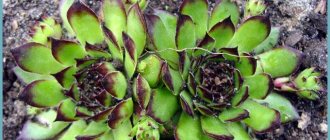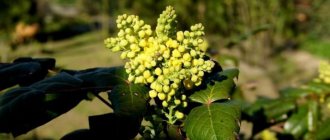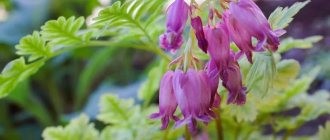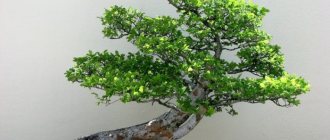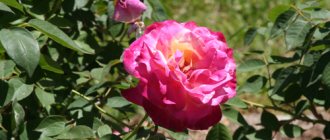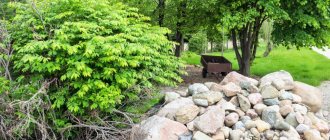Sometimes lovers of flowers, greenery and everything beautiful in their own area advise each other to plant castor beans. And here you can hear the following question: “Castor bean? What is this?". Let's find out what kind of exotic beauty this is, where it grows and what beneficial properties it has. It is quite possible that you will also want to see it on your site.
There are several types of castor beans
From a botany perspective: is castor bean a poisonous plant?
Why did this annual plant of the Euphorbiaceae family receive such a name? The shape of the seeds is similar to the oriental mite, in Latin “ricinuc” - mite. The plant has one large, hollow, erect trunk; numerous branches are crowned with single, large, star-shaped leaves. The leaves can reach 80 cm in length and have pointed edges.
The height of the beauty in Russian temperate climates rarely exceeds three meters, although in the tropics it easily grows to 10 m. In summer, the crown of such a tree is crowned with bright green or red inflorescences with small flowers of cream shades.
Castor bean fruits
The fruits that appear soon are rounded boxes, very similar to prickly balls about 3 cm in diameter. Among the foliage, such spherical boxes look very impressive. The fruits are harvested up to 4 times per season to obtain castor oil.
Castor bean seeds
In autumn, oval-shaped seeds in a smooth shiny shell ripen. The photo shows that castor bean seeds look like mites.
ATTENTION!
The castor bean plant is considered completely poisonous, although the main concentration of the toxic substance is in the seeds.
Popular varieties
Popular varieties of castor beans can be seen on the Internet using photos. They have a beautiful appearance that allows you to make the site bright and original. Many of them are considered poisonous; summer residents, gardeners and flower growers actively plant this plant.
All the poison is contained in the seeds and juice. If you do not come into close contact with it, you can easily avoid poisoning.
Bourbon
Castor bean Bourbon is a species of garden palm. Its unique feature is that its height can reach up to 3 meters. The main qualities of the plant include:
- it resembles a tree due to the presence of a powerful trunk;
- the trunk has a dense structure with a red tint;
- the diameter of the trunk is 15 cm;
- Bourbon castor beans have large leaf blades with a carved shape;
- The plates have a shiny surface and are painted dark green.
Northern palm
Northern castor palm is a woody species. The height of an adult plant reaches two meters. It is used for decorating plots and front gardens.
The unique features of castor beans of the northern palm variety include:
- The plant has unusual leaves with a palmate shape. Their diameter can reach up to 30 cm.
- At the moment of flowering, inconspicuous small flowers appear.
- Flowers form buds with a dense structure and racemose shape. They can reach a length of almost 30 cm.
Zanzibar Green
Castor bean Zanzibar Green is an ornamental flower, it is part of the Malvaceae family. It usually grows up to 250 cm in height. It grows quite quickly.
Castor bean Zanzibar has large leaves with a bright green color. At the moment of flowering, flowers are formed that form dense inflorescences with a racemose shape. They are red in color.
Castor bean hot heart
Castor bean Hot Heart is a very beautiful plant with bright colors. This plant is the most poisonous, for this reason it is not recommended to grow it in the country, in the garden, or in the garden. The main poison is contained in the seeds and thorns, which fly over long distances.
Red castor bean
Ornamental castor bean is a unique plant that is intended to decorate a plot or flower garden. It has beautiful carved foliage that can be colored in different shades - from dark green to bright red. It is very tall and has a powerful trunk, so from the outside it resembles a tree or an ornamental palm tree. There are many types and varieties of castor beans, which may differ according to several criteria - the shape and color of the foliage, height, density, diameter and color of the trunk.
Castor bean: varieties in the garden and places of growth
Uncontrollably interbreeding, castor beans today have somewhat diversified their appearance. According to botanical information, it is customary to call all varieties “common castor bean.” However, it has several forms.
Varieties and photos of the castor bean plant
| Photo | Name | Peculiarity |
| Ordinary | The height does not exceed 1.5 m, the stem is green, the foliage is glossy. | |
| Borbonskaya | Tree-like red trunk, height - 3 m, leaves are very large. | |
| Zanzibar | Reaches 2 m, the largest leaves of all castor beans. Color: dark red. | |
| Indian | Height - 1.2 m. The trunk is black-green, the foliage is dark green. | |
| Gibson | Grows up to 1.5 m. Both the trunk and leaves are dark red. |
Today, this plant is gaining popularity not only due to its decorative qualities, but also as a medical and technical product. The plant is widespread on all continents except Antarctica, as well as in Asia, the Caucasus, Ukraine and the Middle and Lower Volga region.
Types of castor beans
The plant has quite a few varieties, but the most popular are:
- Gibson garden palm;
- Impala;
- Zanzibar;
- Cambodian;
- red;
- Bourbon castor bean species.
Features of growing castor beans: planting and care in open ground
We remember that castor beans do not like frost and shading, so we choose the sunniest place for planting. To know when to plant, we select the planting time taking into account return frosts in your area: the further south you go, the fewer problems there are with growing from seeds.
ADVICE FOR THE VOLGA REGION!
Castor beans can also be grown without seedlings. To do this, the seeds must be soaked in advance in a damp cloth in mid-May, and planted immediately in the ground in a permanent place. It is optimal to throw 2-3 seeds into the hole, dig in and cover with a transparent film until shoots appear.
But you still need to remember that this southern woman comes from Africa. Therefore, we select convenient conditions for it: loose and nutritious soil should always be moistened. If you plant in seedlings, then drop one seed into one container to a depth of 2 cm.
Shoots appear quickly. It is better to remove the oily peel from the cotyledon leaves by first moistening it. This will prevent the plant from rotting.
After the final frosts have passed, the plants begin to be taken outside for hardening. You should not immediately plant all the seedlings in a permanent place. Give the southern beauty a week to get used to other conditions, and then use the transshipment method to plant it in a sunny area.
Castor bean is a heat-loving plant
Growing and care
There should be no serious problems with castor beans in the garden; the plant is relatively easy to grow, it grows like a weed in good conditions, and does not require special care. Castor bean blooms from July to late autumn. She has no serious problems with pests or diseases. Because it grows quickly, it can shade out native flora, forming thickets.
Care procedures:
- Watering . Castor beans do not tolerate drought, but also do not like waterlogging of the soil, which leads to rotting of the roots. Water castor beans on dry days in sunny weather.
- Weed control, mulching . During the initial growing period, it is recommended to remove weeds; later, the plant can choke them out on its own. Mulching will have a positive effect; it will limit the growth of weeds and reduce the drying out of the top layer of the substrate.
- Fertilizer . For proper development, it is worth feeding castor beans with phosphorus and potassium fertilizers. Once a month, you can add all-purpose liquid fertilizer to the watering water and spread a 5-centimeter layer of compost at the base. When the plant begins to form buds, it is worth giving a dose of azofoska or other multicomponent fertilizer.
- Supports. Tall specimens can be tied to stakes, this will limit the possibility of lodging.
- Frost resistance . In Russia, castor beans are grown as an annual plant by sowing seeds. It is very sensitive to frost (seedlings freeze at -1 °C). Mature plants freeze out at -3 °C.
Advice. Those who really want to grow castor beans and have children walking in the garden should think about cutting the inflorescences immediately after flowering. Because the plant requires a minimum of 150 days to set and fully develop seeds, the first inflorescence is sometimes left for seed. To prevent children from reaching for these red balls, you should put a stocking on them and tie them on a stem so that children cannot untie it. The fetus will have the sun, so the processes will continue. Other materials, such as thin agrotextiles, are not suitable for this as they absorb too much light.
Simple rules for caring for castor beans
Experienced flower growers and gardeners have already figured out all the nuances of caring for a flower that looks like a palm tree, and have put all the rules together:
- Abundant and regular watering.
- Frequent weeding, especially during the period after germination.
- Fertilizing with mineral fertilizers containing nitrogen is mandatory in the first half of summer.
All work with the plant is carried out with gloves. After completing all manipulations, you must immediately wash your hands with soap!
Thus, we see that caring for such a garden miracle couldn’t be easier.
The plant is unpretentious in care
Collecting seeds
Collecting seeds is not difficult. But it is necessary to start it while the bush is flowering. At this time, the most beautiful plants are noticed; they will then be the source of seeds.
The seeds are collected in early September and dried in a cool place. The drying period lasts until November, and sometimes until December. Dry pods should practically crumble with the slightest pressure, releasing several seeds that look very much like beans.
All work on extracting seeds is carried out only with gloves, and the resulting seeds are put away in the most reliable place, where household members (especially small ones) and pets cannot reach them.
The benefits and harms of castor beans
Let's compare the beneficial properties of the plant and its harmful qualities.
| Benefit | Harm |
| Useful composition of seeds: up to 60% fatty oil (castor). | The toxic substance is ricin, despite all the processing, some of the poison remains. Ricin has an inhibitory effect on protein biosynthesis at the ribosome level. |
|
The benefits significantly outweigh the toxic qualities of the plant.
What is castor bean
This is a representative of the flora that evokes different emotions. It looks like an exotic palm tree - reaches 6 meters, the leaves are shaped like giant maples, and have an unusual color. Belongs to the Euphorbiaceae family.
Cultivated since the time of the pharaohs, their seeds were found during excavations of pyramids in Ancient Egypt. Having African origin, it has long taken root in Russia. In our area it grows as an annual
Do not forget that castor bean is a poisonous plant. The seeds contain ricin, which if ingested can cause severe poisoning . Don't worry - it's important to place the plant away from the road and avoid contact of animals and children with it.
Castor oil has a number of useful properties - castor oil is made from it, plant cake is used as fertilizer, and also for pest control.
People call it:
- castor oil;
- hemp;
- paradise tree.
The flowers are not very attractive but contain many seeds which are used for planting
Indications and contraindications for use
Medicinal uses of castor beans: laxative, wound healing effect, anti-inflammatory agent.
You should not experience an overdose of castor-based medicines. They say castor bean seeds can easily kill a horse. The author of the article did not check this personally, however, we consider it necessary to warn readers against consuming the seeds of the plant internally. There is no antidote for castor bean poison; it is stronger than potassium cyanide.
REMEMBER!
If you accidentally swallow even a single seed of a plant, you should immediately induce vomiting and make sure that the seed comes out!
Excess castor oil causes stomach upset. Castor bean products are contraindicated during pregnancy and lactating women. In these cases, it is better to ask your doctor for recommendations.
Castor oil must be used with caution
Sowing time
In addition to choosing a variety, it is necessary to correctly determine the time of sowing the seeds. Since the plant is heat-loving, it is planted in open soil after regular warmth has been established.
By the Moon
There is a belief that you can determine the correct sowing time by the phase of the Moon and in which constellation it is located. The most acceptable days are when it is in the growing phase and is in favorable signs:
- March: 24-28.
- April: 2-5, 21-26.
- May: 1-4, 21-26.
In general, cultivation occurs in the spring-autumn period. If we are talking about sowing castor beans at home, then this is the period from March 20 to April 10
Regional influence
The shrub is heat-loving and can grow in any region of the country. It needs to be grown in areas exposed to sunlight; it does not like the cold at all. Of the variety of soils, it prefers nutritious black soil and always high humidity.
However, depending on the region, it is necessary to correctly calculate exactly when to plant seedlings for preliminary forcing:
- Ural. Seeds are sown in March and transferred to the ground when the daytime air temperature reaches +20-22 degrees.
- Siberia. They are sown at the end of April in order to move them into open ground in mid-June, this way you can avoid stretching the shoots.
- Krasnodar region. The best option for planting shoots directly into open ground. Humidity and air temperature encourage seeding to be prepared in March and planted in April.
- Middle lane. Sowing begins in April.
- Moscow and Moscow Region. Seedlings in April, in the garden at the end of May or beginning of June.
- Leningrad region. Planting seeds at the end of March - beginning of April, in open ground - at the beginning of June.
Gardeners who have been doing their business for a long time are advised to rely on forecasts from weather forecasters - if the spring is long and cold, then the seedlings stretch out, weaken and may die. If the region is more southern, then they are planted earlier, for further planting in winter gardens and greenhouses.
In June, the air temperature returns to normal for acceptable planting of crops in open ground, so preparations for planting can begin in April
Bad days
There are so-called unlucky and prohibited days for planting seeds:
- January: 10, 25.
- February: 9, 23.
- March: 9, 24.
- April: 8, 23.
- May: 7, 22.
Where and how to use castor beans
The use of castor oil everywhere: treatment of gastrointestinal inflammation, help with colitis and fever. Castor oil is used externally to remove warts and whiten age spots.
Eyelashes become thicker and longer if you regularly lubricate them at night with castor oil.
In medicine, the oil of this plant helps in the field of gynecology: stimulating the contractile activity of the uterus. An infusion from the plant helps treat gynecological inflammation, colds, and bronchitis.
Properly caring for the plant
Caring for castor beans is not difficult, because it is easy to care for. Therefore, you will not need to make any special efforts. However, if you want it to grow better, use complex mineral fertilizers for feeding. It's a good idea to add a little nitrogen fertilizer before the inflorescence forms. In order for fertilizers to dissolve better, the plant needs to be watered abundantly. If you regularly feed castor beans, they will grow very quickly.
What is the main care? In some simple rules. It is important to loosen the soil regularly. If there are a lot of weeds on it, then the young seedlings will develop very slowly. Even if there is not enough watering, but there are no weeds, the plant will grow much faster. However, if the soil is dry, the plant will not be as beautiful.
It is important to be extremely careful when growing the plant. When collecting castor bean seeds, do not let them touch the skin of your hands. Be sure to use gloves for this. When you have finished the procedure, wash your hands thoroughly.
Even though this plant is unpretentious, it is important to water it well. Then the flowering will be full. During the summer season, watering should be regular - every five days. Pour up to 10 liters per tree.
Photos of castor beans in landscape design: tips
When choosing a variety of southern settlement to plant on your site, you should pay attention to the combination of the tree with other flowers. It is better to set off green forms of the plant with variegated flowers, and red varieties with their red-violet foliage combine effectively with large rose bushes.
Such a beauty will get lost among other tall plants, such as astilbe, dahlias, and lilies. It is best to place the plant in the center of the flower bed, focusing on its growth and leaf size. But then you will have to choose neighbors in the flowerbed who will like some shading from the gorgeous castor bean foliage. Trees that look so much like a palm tree can be planted in a bunch, the spreading nature of the bush is extraordinary!
Here are examples of placing castor bean plants in different photos:
An example of placing castor beans in landscape design
Using castor beans you can create a path in the garden
Growing castor beans from seeds
Sowing
Castor beans can only be propagated by seeds, and they need scarification before sowing. According to statistics, out of 10 sown seeds, only 6 or 7 turn out to be viable. To increase the percentage of germination and scarification is performed, for this the seeds should simply be rubbed on sandpaper, and then immersed in a solution of a growth stimulant (Heteroauxin, Epin, etc.) for 12 hours. ). Seeds can be sown directly into open ground in the last days of April or in May. However, it is preferable to grow castor beans through seedlings, with the seeds sown in March or the first days of April. For planting, it is recommended to use 1 liter plastic buckets, which should be filled ½ with garden soil. Seeds are sown individually, deepening them only 20–30 mm. If the seeds have been scarified, the first seedlings will appear after three or four days. If the sticky peel located on the surface of the cotyledon leaves does not separate on its own, it needs to be helped by using tweezers. Otherwise, rot may develop on the seed.
Sowing castor beans for seedlings
Seedling
The emerging seedling grows very actively. At first, the shoot is stretched, then the first leaf plate is formed, and it is at this time that the seedlings need to be moved to a cool, well-lit place, and it is worth considering that the temperature there should not drop below 15 degrees. As the flower grows, you need to gradually add soil to the container and do this until it is full. If the plant grows very quickly, it will have to be transferred to a larger pot. By the time it’s time to transplant the seedlings into open ground, they can be about 100 centimeters in height.
At what price can you buy castor bean seeds?
Castor bean seeds can be purchased both in online stores and from retailers. There are always seeds available at large garden centers. Typically, the package indicates the name, photo of an adult plant, sowing dates and growing season.
The cost of a pack of seeds varies from 20 to 60 rubles. Beautiful names are variations of the forms we have already indicated above. When buying seeds, choose in advance what such a tall beauty will be combined with on the site.
We hope that we have answered all your questions, we will be glad to see any additions in reviews and comments!
Transfer
Castor bean, a photo of which always makes you want to buy a similar plant, loves fertile soil and a well-lit place. It is determined for a permanent place at the end of May, when frosts definitely cannot destroy the plant.
Before transplanting, seedlings are watered abundantly and carefully transferred into prepared holes. The plant will grow quite large, so it is best to provide each palm tree with its own place. The distance between neighboring plants should be at least a meter.
What are the benefits of castor beans and their oil?
The beneficial properties of castor beans are due to its rich natural composition. Castor oil is produced from its poisonous seeds by cold pressing. To neutralize toxic ricin, the seed extract is treated with steam - under the influence of temperature, the ricin disintegrates and the oil becomes harmless.
Castor bean seeds
Beneficial properties of castor oil:
- normalizes stool, helping to get rid of constipation;
- envelops the mucous membrane of the gastrointestinal tract, providing a protective effect;
- cleanses the digestive system from accumulated toxins and toxic substances;
- stimulates the muscles of the uterus - this is why for many years castor oil has been used to stimulate labor;
- accelerates the healing of wounds, cuts and other skin damage.
Castor oil is widely used in cosmetology as a valuable natural source of beneficial vitamins and minerals. Castor oil strengthens hair follicles, stopping hair loss and stimulating new growth, strengthens eyelash and eyebrow hairs.
Ricin, the main toxic substance in castor beans, after processing has the following properties: a rejuvenating effect, accelerating the natural regeneration of the skin and improving its metabolic processes.
Therefore, castor oil is often added to various cosmetics for face and body skin care.
What is ricin and where is it found?
Castor beans contain two toxic substances - the alkaloid ricinin and toxalbumin ricin. Poisonous ricin is contained in the seeds of the plant, the maximum concentration is in their shell. It is this element that is considered the most poisonous in castor beans.
The alkaloid ricinin is concentrated in all parts of the plant - seeds, foliage, flower buds and cake. During the flowering period, the level of toxin in the leaf blades decreases, and in the flowers it increases.
Poisoning of animals with castor beans
Castor bean (Ricinus communis L.) Euphorbiaceae family - Euphrbiaceae), local names: marvelous tree, Turkish hemp, castor oil, ricin, etc.
Castor bean is known in various places around the world as a tree 10-13m high (in tropical countries), as a 2-3-year-old shrub 3-5m high (in southern Europe) and as an annual herbaceous plant (in mid-latitudes). The root is taproot, splayed and branched. Stem branches are bare, grooved, with alternate, stalked, large, multi-lobed leaves. Castor bean flowers are dioecious, but the plant is monoecious. The fruit is a dry, ovoid, three-lobed capsule; each nest contains one seed. The seeds are ovoid, slightly compressed, with a characteristic mosaic color. The shape and color of the seeds resemble mites, hence the name of the plants.
Poisoning of animals with castor beans occurs when eating green parts of plants, seeds, cakes or meals. Horses, sheep and pigs are most sensitive to poisoning, and cattle to a lesser extent.
Toxicology . The toxicity of castor bean seeds is due to the presence in them of toxoalbumin ricin and the alkaloid ricinin. Once in the digestive tract, ricin leads to the development of inflammation. When released into the blood, it causes an increase in blood clotting, as a result of which blood clots form in the circulatory system and capillary circulation is disrupted. The general effect of ricin in an animal is expressed by shortness of breath (dyspnea), convulsions and paralysis of the central nervous system; at the same time, the poisoned animal experiences severe gastroenteritis, often with bloody diarrhea.
The sensitivity of different animal species to castor bean seeds varies. Horses, sheep and pigs are the most sensitive, and cattle to a lesser extent. The lethal dose of castor bean seeds for horses is 30-50g, for cattle - 350-450g, calves - 20g, sheep - 30g, goats - 105-140g, pigs 60, piglets 15-20g, rabbits -1.5g, geese - 1.0, chickens – 18g.
The cause of poisoning is most often either accidental eating of seeds, or feeding with cakes contaminated with castor bean seeds.
Clinical picture . Poisoning by castor bean seeds in animals is usually clinically manifested in an acute form. In practice, cases have been recorded when poisoned animals suddenly fell and died within a short time. Chronic cases of castor bean poisoning in animals were observed much less frequently.
Cattle . Clinical symptoms in cattle when eating castor bean seeds appear after a significant “latent” period (from several hours to half a day). The first and main symptom of a poisoned animal is severe diarrhea mixed with blood. The general condition of the animal is depressed. No appetite or chewing gum. Body temperature is increased. When palpating the abdominal wall in the area of the scar, we note pain. There is a sharp weakening of cardiac activity (the pulse is increased, the heartbeat is increased). The breathing of a poisoned animal is heavy and labored. A sick animal has difficulty moving. We note a clinical picture of hemorrhagic gastroenteritis in the animal, which can lead to the death of the poisoned animal. Recovery comes slowly, the animal is exhausted.
Sheep . In sheep, as in cattle, symptoms of severe poisoning appeared after 5-6 hours, and in case of mild poisoning, after a day. Poisoned sheep lag behind the general herd, they become depressed and lack appetite. Then the sheep develop diarrhea, the feces become liquid, mixed with mucus and blood. Death in poisoned animals occurs within 1-2 days, and sometimes after a few hours when grazing on pastures where castor beans are present.
In case of mild poisoning, sick animals recovered after 8-10 days. With this form, diarrhea was observed in animals for 4-5 days.
Pigs . When pigs are poisoned by castor beans, the symptoms of poisoning are the same as when poisoning cattle. In pigs we record vomiting and diarrhea; unlike in cattle, diarrhea is not bloody.
Horses . Symptoms of castor bean poisoning in horses appear within 18-24 hours. During a clinical examination, in a poisoned horse, we note depression, which is replaced by anxiety and a desire to move. In case of poisoning, experts note a characteristic symptom in horses - a kind of hiccups, which is caused by convulsive contractions of the diaphragm. Moreover, this symptom in a poisoned horse is observed for several days. From the gastrointestinal tract, poisoning occurs with symptoms of hemorrhagic gastroenteritis, accompanied by violent colic and bloody diarrhea. Body temperature at the onset of the disease may be elevated (40-41°). A poisoned horse sweats profusely. In some cases, animal owners observe general convulsions in poisoned horses. Because of the pain, the animals take an unnatural position, the head and neck are elongated, the stomach is tucked, the gaze is intense with wide open pupils, sometimes a riot is noted in a poisoned horse. In a lying position, the horse hits its head on the ground, throws it up on its chest, looks at its stomach, often tries to get up, assumes a sitting dog pose, jumps up, then falls again. Before death, the animal experiences convulsions.
At the bird . Young birds are more sensitive. Poisoning in a bird is manifested by depression, the wings are drooping, the plumage is ruffled, the beard and comb have a grayish-cyanotic color. Poisoning in chickens has a high mortality rate. Waterfowl are less likely to be poisoned by castor beans; the clinical picture is the same as for chickens.
Pathological changes . When autopsying the corpses of animals that died from castor bean poisoning, we identify signs of severe hemorrhagic inflammation of the mucous membrane of the digestive tract (severe hyperemia, swelling of the mucous membrane, multiple hemorrhages, bloody intestinal contents). The lymph nodes are swollen, the liver and kidneys are enlarged. The lungs are swollen, there is foamy fluid in the bronchi. In birds, upon autopsy, inflammation of the esophagus, crop and stomach is noted.
The diagnosis of castor bean poisoning in animals is made comprehensively based on the collected medical history, clinical signs of poisoning (increased body temperature, which does not occur with other poisonings), the results of a pathological autopsy of the animal, the results of an examination of the feed and the contents of the rumen and stomach. The presence of castor beans in food is detected by finding shells or even whole castor bean seeds. The presence of ricin in feed and cakes can be determined using an agglutination reaction.
Forecast . Depends on the degree of poisoning of the animal. In severe cases it may be unfavorable.
Treatment . Treatment begins with changing the diet. Treatment for poisoning is mainly symptomatic. For a poisoned animal, the stomach is urgently washed with a 1-2% solution of sodium bicarbonate or a 0.1% solution of potassium permanganate. Saline laxatives. Mucous and enveloping agents (decoctions of flaxseed, rice, barley, oats) are prescribed internally. Large animals are given 10 g of methenamine with water 4 times a day and 25 g of sodium bicarbonate once a day. In case of poisoning, pigs are prescribed emetics. In case of collapse (severe general weakness, drop in body temperature, cardiac weakness), cardiac medications are prescribed - caffeine, camphor. For severe pain, use painkillers.
Prevention . Owners of private household plots, peasant farms and agricultural enterprises should not allow animals to graze on castor bean crops, as well as after harvesting. Avoid contamination of feed with castor bean seeds. Castor bean meals and cakes for feeding animals can only be used after boiling for 2 hours or after autoclaving for 1-1.5 hours, at a pressure of 1.5-2 atmospheres, or after washing with a solution of table salt (1:6) in within 6-8 hours.
Cossack woman
Castor bean Cossack grows up to 2 m per season. It has shiny dark green leaves with reddish veins, and young foliage is red-violet.
Cossack blooms with bright red flowers. The boxes in which the seeds ripen are decorative: elegant in shape, purple in color.
Plants are planted near a fence or against the wall of a house. Cossack can serve as a background for other flowers in a multi-tiered flower bed. It is better to choose a warm and bright place for it on the site; the soil should be fertile and constantly moist.
The variety is grown by seedlings, the seeds hatch 12 days after sowing. Before planting, the soil needs to be fertilized. After a couple of weeks, fertilizing is repeated. You need to water the bush at the first sign of drying out of the top layer.

